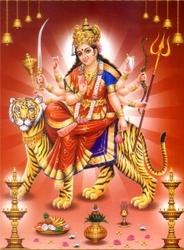 Durga, also known as Shakti or Devi is one of the most popular goddesses among the Hindus. She represents strength, morality, power and protection. She is the divine mother, who protects people from evil forces of selfishness, jealousy, hatred, anger and ego. Durga means something that is inaccessible, invincible or one who can redeem in situations of utmost distress. She is the supremely radiant goddess who has ten arms, rides on a lion, carries weapons and a lotus flower. She is an embodiment of feminine force (Shakti) and creative energy. She is mother of Ganesha, Kartikeya, Saraswati and Lakshmi. Actually, Durga is the warrior aspect of the Divine Mother. Other incarnations of Durga include Annapurna and Karunamayi. Durga’s darker aspect is called Kali. Kali is often represented to be standing on the body of God Shiva.
Durga, also known as Shakti or Devi is one of the most popular goddesses among the Hindus. She represents strength, morality, power and protection. She is the divine mother, who protects people from evil forces of selfishness, jealousy, hatred, anger and ego. Durga means something that is inaccessible, invincible or one who can redeem in situations of utmost distress. She is the supremely radiant goddess who has ten arms, rides on a lion, carries weapons and a lotus flower. She is an embodiment of feminine force (Shakti) and creative energy. She is mother of Ganesha, Kartikeya, Saraswati and Lakshmi. Actually, Durga is the warrior aspect of the Divine Mother. Other incarnations of Durga include Annapurna and Karunamayi. Durga’s darker aspect is called Kali. Kali is often represented to be standing on the body of God Shiva.

Maa Durga’s weapons:
- Rudra’s trident
- Vishnu’s discus
- Indra’s thunderbolt
- Brahma’s kamandalu
- Kuber’s Ratnahar
According to Markandeya Purana, Durga was a warrior goddess to fight a demon called Mahishasura. The demon’s father Rambha, king of the demons, once fell in love with a water buffalo, and Mahishasur was born out of this union. He is therefore able to change between human and buffalo form at will (mahisha means “buffalo”). Through intense prayers to Brahma, Mahishasura got the boon that he could not be defeated by any man or god. He unleashed a reign of terror on earth, heaven and the nether worlds. Mahishasur had unleashed on the three worlds.
Troubled by this powerful demon, the Gods went to Brahma but he said he could not do anything. Then all the Gods with Brahma went to Vaikuntha (the place where Vishnu lay on Ananta Naag). There they found Lord Shiva also. Brahma described the reign of terror of Mahishasur. Hearing this Vishnu, Shiva and all of the Gods became very angry and beams of fierce light emerged from their bodies. The blinding sea of light met at the Ashram of a priest named Katyan. The goddess Durga took the name Katyaayani from the priest and emerged from the sea of light. She introduced herself saying she was the form of the supreme Brahman who had created all the gods. Now she had come to fight the demon to save the gods.
On his initial encounter with Maa Durga, Mahishasura underestimated her, and said: “How can a woman kill me?” Hearing this, Durga roared with laughter, which caused an earthquake which made Mahishasur aware of the powers of Maa Durga.
And the terrible Mahishasur rampaged against her, changing forms many times. First he was a buffalo demon, and she defeated him with her sword. Then he changed forms and became an elephant that tied up the goddess’s lion and began to pull it towards him. The goddess cut off his trunk with her sword. The demon Mahishasur continued his terrorizing, taking the form of a lion, and then the form of a man, but both of them were gracefully slain by Durga.
Then Mahishasur began attacking once more, starting to take the form of a buffalo again. The patient goddess became very angry, and as she sipped divine wine from a cup she smiled and proclaimed to Mahishasur in a colorful tone – “Roar with delight while you still can, O illiterate demon, because when I will kill you after drinking this, the gods themselves will roar with delight”. When Mahashaur had half emerged into his buffalo form, he was paralyzed by the extreme light emitting from the goddess’s body. The goddess then resounded with laughter before cutting Mahishasur’s head down with her sword. Therefore, Maa Durga is also known as Mahishasurmardhini – the slayer of Mahishasur.
According to some other story, Maa Durga created an army to fight against the demon-king Mahishasur and after 10 days of fighting, She and her army defeated Mahishasur and killed him. That is the reason why the day of Durga’s victory is celebrated as Vijayadashami means victory on 10th day.
Durga Puja is celebrated for nine days (Navaratri) followed by one last day called Vijayadashami. However, in some parts of India, Vijayadashami also signifies Lord Ram’s victory in his battle against the demon Ravan.
In 2010, Durga Puja runs from October 13-17. The dates of the festival ::
13th October 2010 —- Sasthi
14th October 2010 —- Saptami
15th October 2010 —- Mahashtami
16th October 2010 —- Navami
17th October 2010 —- Vijaya Dasami
Nine forms of Maa Durga:
1) Shailputri

In this form Durga is two-armed and carries a trident and lotus. Her mount is an ox or bull. Shailputri means the daughter of the mountain, Himalaya. In this form we see the divine Mother holding a trident in her right hand and a lotus on her left. She is seen seated on an ox. In her previous birth, she was called Sati, Bhavani and was the daughter of King Daksha. After a lot of penance, she married Lord Shiva. But her father King Daksha was not too happy. He had arranged for a Yagya/Yagna (Ritual done around the sacrificial fire) where he invited everyone except his son-in-law, Lord Shiva. Upset and feeling humiliated, Sati decided to attend the event uninvited. There, her father insulted Lord Shiva and in fury she stood on the sacrificial fire and burnt herself alive. Lord Shiva enraged, ordered his followers to demolish the Yagya. Sati was reborn as the daughter of the king of the mountains, Himalaya in the name of Parvati – Hemvati and got married with Lord Shiva again. This form of her is worshipped on the first day of the Navratri celebrations.
2) Brahmacharini
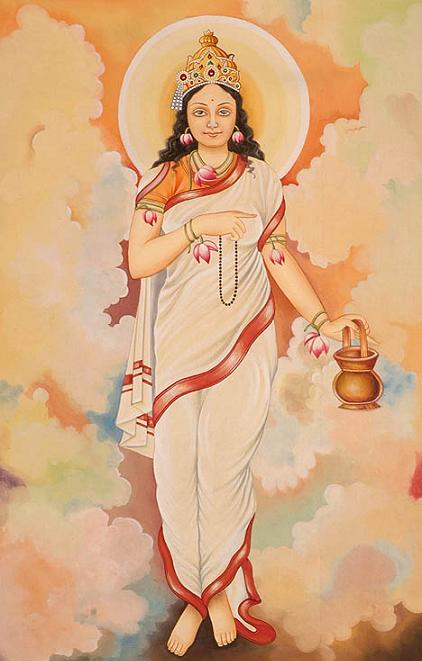
In this form Durga is two-armed and carries a rosary and sacred water pot (Kamandal). She is in a highly pious and peaceful form or is in meditation. This form of Durga is related to the severe penance undertaken by Sati and Parvati in their respective births to attain Lord Shiva as husband. Some of the most important Vratas observed in different parts of India by women is based on the strict austerities followed by Brahmacharini. She is also known as Tapasyacharini and is worshipped on the second day of Navrathri.
3) Chandraghanta
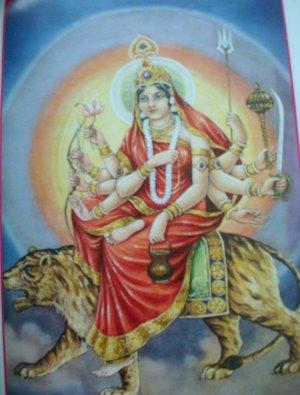
Goddess Durga’s third form is known as Chandraghanta or Shakti. Chandra means moon and Ghanta is the bell. This name finds its explanation in the half-circular moon on the temple of the Goddess that resembles a bell. She is three eyed with ten hands. Each hand holds ten different weapons. She is seated on lion and is worshipped on the third day of the Navratri celebration. Her hue is golden and her appearance always spreads a calm and eternal peace all round. She is unprecedented image of bravery. The frightful sound of her bell terrifies all the evil and demon. Worship of this deity helps to eliminate the sorrow, hazards and dangers in ones life.
4) Kushmanda:
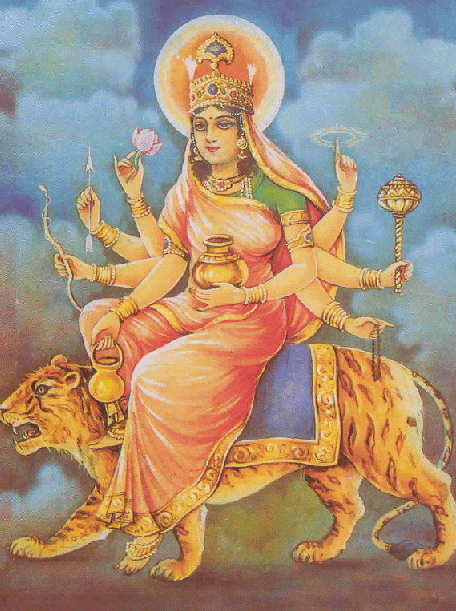
In this form Durga is eight-armed and rides on a tiger. She holds kamandalu, bow, arrow, lotus, pot containing wine, disc, rosary and a club. She is very happy in this form and it is believed that the eternal darkness ended when she smiled. And this led to the beginning of creation. Kushmanda form of Durga is worshipped on fourth day of Navratri.
5) Skanda Mata
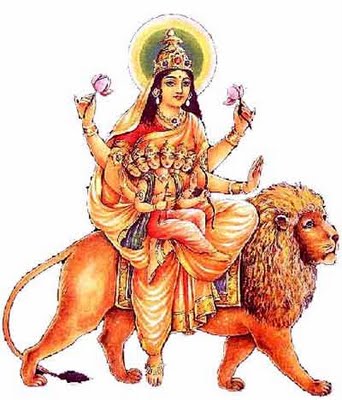
Lord Kartik/Kartikeyan/Karthikeyan is also known as Skanda. As Goddess Durga is his mother, she is referred to as Skanda Mata. She is a deity of fire with four arms. She holds her son Skanda with the top right hand and lotus in her lower hand. The top left hand is positioned in a blessing gesture or Abhaya Mudra. She is fair complexioned, seated on a lotus and so also referred to as Padmasana.
6) Katyayani:
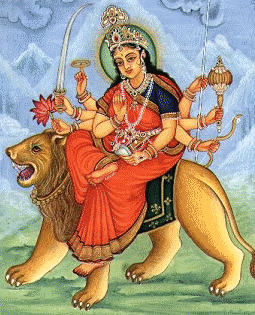
Sage Katyaayan was the son of the great sage Kat. He observed rigorous penance and worship of Bhagavati Paramba with a desire to get Paramba as his daughter. His wish was granted. The daughter born was named Katyayani. She has four hands. The top right hand is positioned in a gesture of providing courage while the other hand is positioned in a gesture of rendering a boon. The top left hand holds a sword and the other a lotus. The goddess rides a lion and worshiped on the sixth day of the Durga puja.
7) Kalratri:
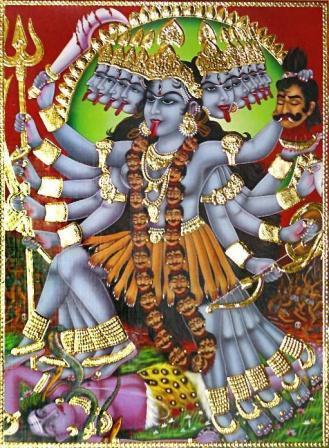
Ratri means night so her complexion is as dark as the night. She has long, unmated hair with her three eyes that are shiny and bright. She has four arms and is seen mounted on a Shav/Shava or dead body. Her right hand holds a sword, while her lower hand is in a blessing stance. The left hand holds a burning torch and the lower left hand is in fearless position. She is known as Shubhamkari or the auspicious one. Her form encourages her devotees to be fearless.
8 ) Maha Gauri:
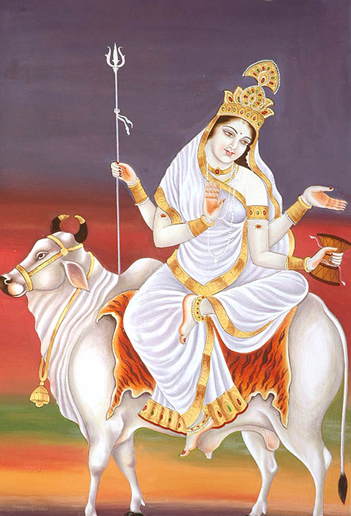
It is said that when the body of Goddess Gauri got dirty due to dust and earth while she was observing penance to attain Lord Shiva. So he cleansed her with the holy waters of Ganges. Her body transformed into bright and luminous like lightening and so her eighth form is known as “Maha Gauri” .Her clothes and ornaments are also white. Her visage is calm and peaceful and she is three eyed. She rides on a bull. Her four hands denote different meanings, like the left hand is in the fearless gesture and the lower on holds a trident. The above right hand has tambourine and lower right hand is in blessing style.
9) Siddhidatri:
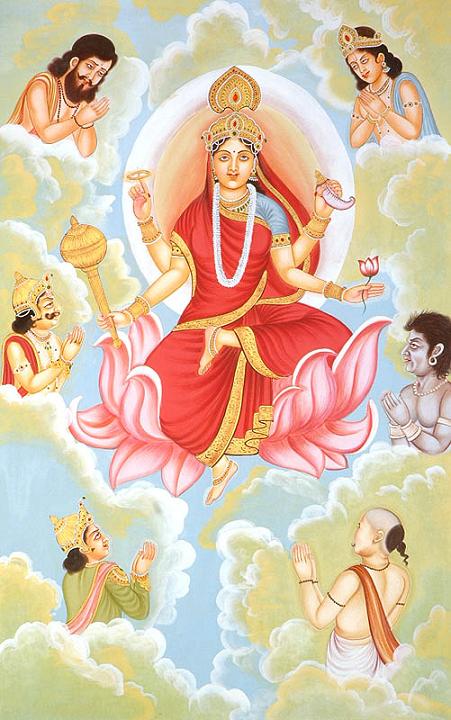
The ninth form is Siddhidatri. There are eight Siddhis (Special powers which can only be attained from severe penance and meditation)-Anima, Mahima, Garima, Laghima, Prapti, Prakamya, Iishitva & Vashitva. Maha Shakti gives all these Siddhies. It is mentioned in the Devi Puran” that Lord Shiva got all these Siddhis by worshipping Maha Shakti. With her gratitude, Lord Shiva’s body also contains the Goddess and so he has the form and name of Ardha Narishvar. Ardha means half. The goddess rides on a lion. The Siddhidatri form is worshipped by all gods, rishis, munis (Saints and Sages), siddhas, yogis, sadhakas (Devotees) for attaining merit and boons of their severe penances.
Mantras for Maa Durga are as follows:
Na Mantram No Yantram Tadapi Cha Na Jane Stutimaho Na Chavhanam Dhyanam Tadapi Cha Na Jane Stutikathah I
Na Jane Mudraste Tadapi Cha Na Jane Vilapanam Param Jane Matastvadanusaranam Kleshaharanam II
Meaning: O Maa Durga! I don’t know any prayer or any magical summons to invoke you. Neither I know any mantra and have no idea how to meditate on you. I don’t know your story or glory as well. I neither know your various postures nor am I given to crying in distress. The only thing I know is that seeking shelter under your protection and following your command will definitely end all sufferings.
Vidheragyanen Dravinavirhenalasataya Vidheyashakyatvattva Charanyorya Chyutirbhut I
Tadetat Kshantavyam Janani Sakaloddharini Shive Kuputro Jayet Kwachidapi Kumata Na Bhavti II
Meaning: O Durga, assure salvation to all troubled, I don’t know how to worship you. I don’t have resources or temperament since I am nasty by nature. I don’t have special knowledge to conduct your worship as well. In rendering service to you if, I have made any mistakes or errors, forgive me Mother because there could be a bad son but never a bad mother.
Prithivyam Putraste Janani Vahavaha Santi Saralah Param Tesham Madhye Viralataraloaham Tava Sutah I
Madi Yoayam Tyagah Samuchitamidam No Taya Shive Kuputro Kwachidapi Kumata Na Bhavati II
Meaning: O Maa Durga, this earth has many of your naïve sons, but I am the most fickle among them. There would be hardly any one like me. Yet, O Shive! Rejecting me like this is not proper in this world, as there could be a bad son but never a bad mother.
Jaganmatarmatastava Charanseva Na Rachita Na Va Duttam Devi Dravinamapi Bhooyastava Maya I
Tathapi Tvam Sneham Mayi Nirupam Yatprakurushe Kuputro Jayet Kwachidapi Kumata Na Bhavati II
Meaning: O Mother of the World! I have never rendered any service to you. I never offered money to you. Yet, you bless me always for the reason that in this world there could be a bad son but never a bad mother.
Parittyakta Deva Vividhavidhisewa Kulataya Maya Panchasheeteradhikamapneete Tu Vayasi I
Idani Chenmatastava Yadi Kripa Napi Bhavata Niralambo Lambodar Janani Kam Yami Sharanam II
Meaning: O Parvati, mother of Lord Ganesha, I had been busy restlessly. But now, I have stopped worshipping other gods as I cannot worship them ritually. Therefore, I don’t even expect any help from them. In such a condition I am absolutely helpless. From whom I seek shelter? I have no hope from any other god except you.
Shwapako Jalpako Bhavti Madhupako Magira Niratanko Ranko Viharati Chiram Kotikanakaih I
Tavaparne Karne Vishati Manvarne Phalamidam Janah Ko Janeete Janani Japaneeyam Japvidhhau II
Meaning: O Maa Aparna! One word of your holy prayer that falls in the ear of a foolish rascal is sufficient to make him utter sweet speech like an experienced scholar. With your blessing, a pauper then becomes rich owning millions of gold coins and enjoying life with all its joys till ripe old age. When listening to one word can work such wonders, who can presume the reward obtained by those, who continuously chant your name with full custom of worship.
Chitabhasmalepo Garalamashanam Dikpatdharo Jatadhari Kanthe Bhujagapati Hari Paushupatih I
Kapali Bhootesho Bhajati Jagdeeshai Ka Padavin Bhavani Tvatpanigrahan Paripati Phal Midam II
Meaning: O Durga Bhavani! The one, who keeps his body smeared with the ashes of the dead-bodies; who takes poison for food, who remains naked; who has matted hair on head and the serpent king Vasuki surrounding his neck; who has a cupal like container in his hands. If such a Bhootnath, Lord Shiva (Pashupati-Lord of Animals) is crowned with a title of Jagdeesh, then what is the reason behind it? How did he gain such importance? The clear evidence is your marriage with him.
Na Mokshasyakancha Bhavavibhavavancha Cha Na Mey Na Vigyanapeksha Shashimukh Sukheccha Na Punah I
Atastvan Sanyache Janani Jananam Yatu Mum Vai Mridani Rudrani Shiv-Shiv Bhavaneeti Japatah II
Meaning: O Maa Durga, with face of moon’s elegance, I don’t crave for Salvation or for material possessions. I don’t even hope to get any expertise in sciences. I don’t long for pleasure as well. My only request to you is to permit me to pass my entire life chanting “Mridani Rudrani Shiva-Shiva Bhavani”.
Naradhitasi Vidhina Vividhopachareh Kim Rukshachintak Pareirna Kritam Vachobhib I
Shayme Tvameva Yadi Kinchan Maiyyanathe Dhatse Kripamuchitalam Param Tavaiva II
Meaning: O Maa Shyama! I never worshipped you with complete rituals or lots of offerings. I was always occupied in harsh words, which crime did my speech not commit? Yet, if you care for this shelter less orphan on your own, this is eligible only for you. Only a kind hearted mother like you can give refuge to such a bad son, as I am.
Aapatsu Magnah Smaranam Tvadeeyam Karomi Durge Karunarna Veshi I
Naitaccha Thatvam Mum Methah Kshudhartrisharta Jananim Smaranti II
Meaning: O Compassionate Goddess Durga! If I remember you after falling in trouble and not before, please do not treat me like a dishonest rogue for the reason that all children yell for mother when they are troubled.
Jagdamb Vichitramatra Kim Paripoorna Karunaasti Chenmayi I
Aparadha Parampara Param Na Hi Mata Samupekshate Sutam II
Meaning: O Mother of the World! If you still show your kindness towards me should not cause any surprise for the reason, if a son has bent on committing sin after sin, still his mother does not abandon him.
Matsamah Palaki Nasti Papaghni Twatsama Na Hi I
Evam Gyatva Mahadevi Yatha Yogyam Tatha Kuru II
Meaning: O Maa Durga! I am the greatest sinner and you are the greatest sin-destroyer. Considering this fact in mind, kindly do whatever you think proper.
108 Names of Maa Durga::
- Bhaavya Represents Future
- Bhavya With Magnificence
- Mahatapa With severe penance
- Manah Mind
- Buddhi Intelligence
- Ahankaara One with Pride
- Chittarupa One who is in thought-state
- Chita Death-bed
- Chiti The thinking mind
- Sati One who got burned alive
- Saadhvi The Sanguine
- Bhavaprita One who is loved by the universe
- Bhavaani The abode of the universe
- Bhavamochani The absolver of the universe
- Aarya Goddess
- Durga The Invincible
- Jaya The Victorious
- Aadya The Initial reality
- Trinetra One who has three-eyes
- Shooldharini One who holds a monodent
- Pinaakadharini One who holds the trident of Shiva
- Chitra The Picturesque
- Chandaghanta One who has mighty bells
- Sarvamantramayi One who possess all the instruments of thought
- Satta One who is above all
- Satyanandasvarupini Form of Eternal bliss
- Ananta One who is Infinite or beyond measure
- Bhaavini The Beautiful Woman
- Vikrama Violent
- Krrooraa Brutal (on demons)
- Sundari The Gorgeous
- Sursundari Extremely Beautiful
- Vandurga Goddess of forests
- Maatangi Goddess of Matanga
- Matangamunipujita Worshipped by Sage Matanga
- Braahmi Power of God Brahma
- Maaheshvari Power of Lord Mahesha (Shiva)
- Aeindri Power of God Indra
- Kaumaari The adolescent
- Sarvaastradhaarini Possessor of all the missile weapons
- Anekashastrahasta Possessor of many hand weapons
- AnekastraDhaarini Possessor of many missile weapons
- Komaari The beautiful adolescent
- Ekakanya The girl child
- Kaishori The adolescent
- Yuvati The Woman
- Yati Ascetic, one who renounces the world
- Sarvavidya Knowledgeable
- Dakshakanya Daughter of Daksha
- Vaishnavi The invincible
- Chaamunda Slayer of Chanda and Munda(demons)
- Vaarahi One who rides on Varaah
- Lakshmi Goddess of Wealth
- Apraudha One who never gets old
- Praudha One who is old
- Abhavya Improper or fear-causing
- Sadagati Always in motion, bestowing Moksha (salvation)
- Shaambhavi Consort of Shambhu
- Devamata Mother Goddess
- Chinta Tension
- Ratnapriya Adorned or loved by jewels
- Dakshayajñavinaashini Interrupter of the sacrifice of Daksha
- Aparna One who doesnt eat even leaves while fasting
- Anekavarna One who has many complexions
- Paatala Red in color
- Paatalavati Wearing red-color attire
- Pattaambaraparidhaana Wearing a dress made of leather
- Kalamanjiiraranjini Wearing a musical anklet
- Ameyaa One who is beyond measure
- Vriddhamaata The old mother (loosely)
- Balaprada The bestower of strength
- Mahodari One who has huge belly which stores the universe
- Muktakesha One who has open tresses
- Ghorarupa Having a fierce outlook
- Mahaabala Having immense strength
- Agnijwaala One who is poignant like fire
- Raudramukhi One who has a fierce face like destroyer Rudra
- Kaalaratri Goddess who is black like night
- Tapasvini one who is engaged in penance
- Narayani The destructive aspect of Lord Narayana (Brahma)
- Bhadrakaali Fierce form of Kali
- Vishnumaya Spell of Lord Vishnu
- Jalodari Abode of the ethereal universe
- Shivadooti Ambassador of Lord Shiva
- Karaali The Violent
- Ananta The Infinite
- Purushaakriti One who takes the form of a man
- Vimalauttkarshini One who provides joy
- Gyaana Full of Knowledge
- Kriya One who is in action
- Nitya The eternal one
- Buddhida The bestower of wisdom
- Bahula One who is in various forms
- Bahulaprema One who is loved by all
- Sarvavahanavahana One who rides all vehicles
- NishumbhaShumbhaHanani Slayer of the demon-brothers Shumbha Nishumbha
- MahishasuraMardini Slayer of the bull-demon Mahishaasura
- MadhuKaitabhaHantri Slayer of the demon-duo Madhu and Kaitabha
- ChandaMundaVinashini Destroyer of the ferocious asuras Chanda and Munda
- Sarvasuravinasha Destroyer of all demons
- Parameshvari The Ultimate Goddess
- Katyayani One who is worshipped by sage Katyanan
- Savitri Daughter of the Sun God Savitr
- Pratyaksha One who is real
- Brahmavaadini One who is present everywhere
- Sarvadaanavaghaatini Possessing the power to kill all the demons
- Sarvashaastramayi One who is deft in all theories
- Satya The truth
Once again Maa Durga is back to the earth. We all are eagerly waiting for the auspicious festival of Durga Puja. We celebrate Durga Puja to mark the victory of Goddess Durga over the evil demon Mahishasura. It is celebrated during the last five days of Navaratri.
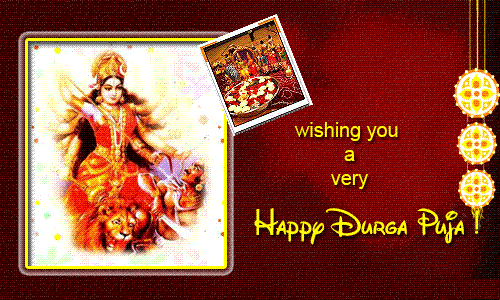


This is a great post about the maa.
thx for providing such a gr8 information!
Jai Mata Di@~@~@~@~@~@
Good piece of information on the goddess. Durga puja is a festive occasion for widespread celebration for people in Kolkata and the rest of West Bengal. Nice article dude.
Its wonderful and nice to learn mythological basics. Thanks
It is very informative, systematic and in presentable manner. I admire the style of writer. thanks for such knowledge in complete form at one place. Jai Maa Durga……
Thank you so much for Posting and very good article
Very informative with good knowledge on Maa Durga. Thanks.
Such a wonderful post about Maa Durga.